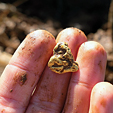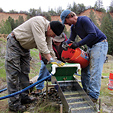All Articles
Legislative and Regulatory Update
August 2000 by Staff
Every prospector and claim holder should be aware of the court decision USA v. Shumway (96-16480) from the U.S. 9th Circuit Court of Appeals filed December 28, 1999.The Shumways received their first Forest Service operating plan approval in 1979. In 1981, the Forest Service approved a cyanide leaching operation. The Forest Service required the Shumways to have someone live on-site to discourage vandalism. Mr. Shumway stated that Rodney Byers of the Forest Service later told him that he "would try to figure out a way to get me off of' the claims before patents were issued.
In 1987, the Forest Service directed Shumway to stop stabling a horse on the property, and to clean up trash and junk. Shumway felt he needed the horse to inspect the perimeter of his mill sites and to inspect mines in the forest because no motor vehicles were allowed. Shumway stated in his affidavit that "the equipment and materials stored on the mill sites have been or were incidental to the milling operations."
Also in 1987, the Forest Service ordered the Shumways out of their travel-trailer home on one of the sites despite a previous requirement that someone live on-site to prevent vandalism. The Forest Service stated their reason for this change was because no more cyanide leaching was taking place.
The Forest Service also changed the bond requirements several times. In 1979, they required a $2,000 cash or surety bond for reclamation. In 1980, it was increased to $3,200. In 1990, the Forest Service raised the required bond to $18,000—even though less ore was being processed than in 1980, and no more cyanide leaching was taking place.
The Shumways submitted a corporate surety bond, but the Forest Service rejected it. The Forest Service stated that the company used by the Shumways to obtain the bond was not on the approved list of companies maintained by the Treasury Department.
The Shumways unsuccessfully appealed the bond increase. They found that no company on the Treasury Department list was writing these types of bonds. The Shumways did not have $18,000 in cash.
In 1991, the Forest Service ordered them to stop all milling and mining and leave their residence on the mill site because they had not posted the increased bond. The Forest Service then advised the Shumways that they could expect the bond to be raised to $150,000 to $200,000 if they tried to obtain approval for a new operating plan.
In 1994, the Shumways applied for patents to their mill sites. The document that precedes a patent, the "First Half of the Mineral Entry Final Certificate," was signed by the Secretary of the Interior himself on December 1, 1994.
The Shumways were advised that a patent would be issued "if all is found regular and upon demonstration and verification of use and/or occupancy." This was to be verified "by a mineral examiner in an on-the-ground examination." As of the summer of 1995, the Arizona BLM was proceeding with only two field examinations, and those had been requested seven and eight years before. There were eleven more pending and the Shumway case was not even assigned to a mineral examiner.
In 1995, the United States sued the Shumways to evict them, remove all property, and clean up their sites. The complaint stated that no milling was being conducted, no plan of operations was in place, the required bond was not posted, and they were trespassing. The district court found in favor of the government and the Shumways appealed.
The case went before Judge Kleinfeld of the 9th Circuit Court of
Appeals. He reversed the district court decision. The following are selected quotes from the ruling:
"Despite much contemporary hostility to the Mining Law of 1872 and high-level political pressure by influential individuals and organizations for its repeal, all repeal efforts have failed, and it remains the law."
"The Supreme Court has established that a mining 'claim' is not a claim in the ordinary sense of the word—a mere assertion of a right—but rather is a property interest, which is itself real property in every sense, and not merely an assertion of a right to property."
" ... the government cannot reserve its own land from an unpatented mining claim without paying the owner the value of the claim, because an unpatented mining claim is property."
"It has long been established that if the applicants are in compliance with the mining laws, then their right to the unpatented claim, or the 'title of a locator' is vested even though the Department of the Interior has as yet taken no action at all on their application for a patent. That an applicant has yet to receive, or even apply for, a patent does not mean that the government has plenary power over the mill site."
"The owner of a mining claim owns property, and is not a mere social guest of the Department of the Interior to be shooed out the door when the Department chooses."
"Even if the Shumways' right to a patent has not vested, they may still defeat a motion for summary judgement, if they demonstrate that the Forest Service raised the bond requirements arbitrarily, and unreasonably circumscribed their milling operations."
"The Multiple Use Act empowers the Forest Service to regulate non-mining activity upon mining claims, so long as the non-mining activity does not interfere with mining activities or 'uses reasonably incident thereto.'''
"While the Forest Service might regard the equipment on the Shumways' sites as junk, it has not proved it. The Shumway affidavit establishes a genuine issue as to whether the equipment and materials are incidental to his milling operations. "
"In particular, the Forest Service's photographs, submitted to show the 'junk,' display much that plainly is not. For example, a photograph of a pile of tires is submitted to show 'junk.' But to anyone who drives much on bad, unpaved roads, what is notable about the tires is that they are mounted on intact steel wheels. If the Shumways drive the rigs shown in the exhibits, then it is extremely plausible, as Mr. Shumway says in his affidavit, that these mounted tires are equipment incidental to his milling operations. That the Forest Service calls what appear to be good wheels 'junk' may reflect a lack of competence on its part to evaluate other people's equipment, rather than a lack of value of the equipment."
" ... the Forest Service may regulate use of National Forest lands by holders of unpatented mining claims, like the Shumways, but only to the extent that the regulations are 'reasonable' and do not impermissibly encroach on legitimate uses incident to mining and mill site claims. Congress has refused to repeal the Mining Law of 1872. Administrative agencies lack authority effectively to repeal the statute by regulations."
"The Forest Service may also require a mine or mill site operator to furnish a bond to secure compliance with the plan of operation's reclamation requirement. Because the bond is linked to the reclamation goals of the plan of operations, the bond amount may not be set arbitrarily."
"The Forest Service's Complaint asked the court to evict the Shumways because they had not filed a plan of operations nor the required bond. The Shumways argue that the Forest Service would not accept their plan until they filed the requested bond. But the bond amount, argue the Shumways, was impermissibly arbitrary."
"Based on our review of the evidence before the trial court, there is an issue of fact as to whether or not the government [im]properly increased the bond amount to an arbitrary figure, and threatened additional arbitrary increases if the Shumways met the figure."
" ... the Shumways presented evidence contradicting the Forest Service's assertion that the mill site operations had changed substantially and that their equipment and materials were "junk.'"
"Nor does the record provide a basis for evicting the Shumways. There is uncontradicted evidence that the Shumways own the mill site claims."
"The Forest Service has offered no explanation for why its disapproval of an operating plan should result in eviction."
"Failure to file an approved operating plan cannot, ipo facto, cause a forfeiture of the bona fide claim owner's equitable title and possessory right. The Shumways are not guests at their mill site, but propertyowners."
Judge Wallach concurred with Judge Kleinfeld's opinion, and had this to say:
"The, Forest Service would do well to remember that miners explored and built much of the western United States using long-established techniques, some of which dated from the Middle Ages. Many of those methods are still perfectly workable. Mining equipment, especially that used in grading, crushing, and grinding ore may well be old, battered, and rusty and yet still entirely serviceable, particularly for small operators. It is hardly 'junk.'"
This ruling is an important reaffirmation of the rights of claim holders. There are many other good points made and the judge provides a good historical basis for his decisions. Unfortunately, I cannot include the entire nineteen pages in ICMJ. I encourage you to obtain a copy of the ruling at the web address listed below. Share it with clubs, associations, and fellow miners.
Thanks to the readers who have called this case to my attention, and a special thanks is extended to Dave Brooks.
To review the entire case, go to: http://laws.findlaw.com/9th/9616480.html

Know Your District
We have to remember that the earliest miners were not geologists, but came from a variety of backgrounds. Their survival depended on finding enough gold so they worked hard and adapted to whatever challenges these new areas presented.
Looking Back
Excerpts from California Mining Journal, our original title, published 50 years ago this month.
Revisiting The Old Mini Patch
 Today, the greatest gold rushes occur due to technological advances capable of discovering gold where it once was extremely unlikely or difficult.
Today, the greatest gold rushes occur due to technological advances capable of discovering gold where it once was extremely unlikely or difficult.
Melman on Gold & Silver
Who would have thought it possible? According to a New York Times editorial in late January, they predict that the terrorist attack on September 11 will not be remembered by historians as the most significant event of the last half of 2001. Their new choice is the collapse of corporate giant Enron—and they just may be right.
I-147 Before Montana Supreme Court
A group supporting a ballot measure to overturn a ban on using cyanide in certain mines has told the Montana Supreme Court it should throw out a lawsuit against Initiative 147. Facts surrounding the claims of I-147 opponents must be sorted out before the high court can consider the legal challenge, said proponents who call themselves Miners, Merchants and Montanans for Jobs and Economic Opportunity.
What Equipment Do I Need?
 Getting started in prospecting often requires the purchase of some equipment, but one can spend as little as $10 and be finding gold or spend thousands and also be finding gold—yet you will probably have many more opportunities and possibilities with more and better equipment.
Getting started in prospecting often requires the purchase of some equipment, but one can spend as little as $10 and be finding gold or spend thousands and also be finding gold—yet you will probably have many more opportunities and possibilities with more and better equipment.
Subscription Required:
The Bawl Mill
• Our Readers Say
• August Hearing Set for Crandon Mine
• Montana Approves Stillwater Expansion Bonds
• Guest Editorial—Globalizing Mining in America, Part I
• Quartzsite, Arizona
• Groups Plan to Sue Over Lynx Protection
• Picks & Pans: Treasure Hawk Mine—Cutthroat Mining Corporation
• Company Notes
• Nuggetshooting Eluvial Placers in the Western United States
• 125 Years of Mining History in the Panamints
• Cuba Revisited
• 2000 National Mining Hall of Fame Inductees
• United States National Gold Panning Championships
• Melman on Gold & Silver
• Mining Stock Quotes and Mineral & Metal Prices
Free:








